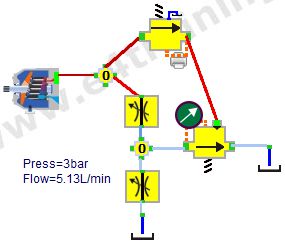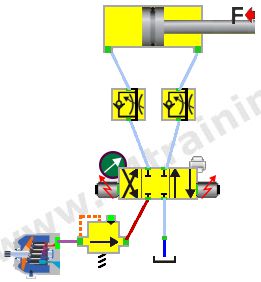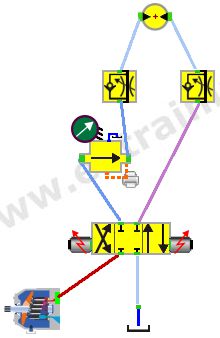Topics and Outcomes
Expected outcomes: Understand the different types of pressure control valve with examples of the main performance issues and how they are used.
Level: 2-4 Novice to improver
Topic covered: Direct and pilot operated pressure control valves
- Remote operated pressure control valves
- Pressure reducing valves
- Sequence valves
- Measuring performance and setup issues
Direct acting pressure relief valve

 Question: What happens when the relief valve's pressure setting is changed?
Question: What happens when the relief valve's pressure setting is changed?
 Experiment: Open circuit Pressure/1_Direct Operated Relief Valve. Move the test gauge over the relief valve. Click on the relief valve symbol. Change the pressure setting and observe how the upstream pressure changes.
Experiment: Open circuit Pressure/1_Direct Operated Relief Valve. Move the test gauge over the relief valve. Click on the relief valve symbol. Change the pressure setting and observe how the upstream pressure changes.
 Question: What happens when the return line pressure increase to 5 bar?
Question: What happens when the return line pressure increase to 5 bar?
 Experiment: Set the relief valve to 100 bar. Click on the tank symbol and change the pressure to 5 bar. Observe how the pressure upstream of the relief valve changes. Try other pressures then return to 0.5 bar.
Experiment: Set the relief valve to 100 bar. Click on the tank symbol and change the pressure to 5 bar. Observe how the pressure upstream of the relief valve changes. Try other pressures then return to 0.5 bar.
 Question: Is the actual pressure dependent on the pump flow rate?
Question: Is the actual pressure dependent on the pump flow rate?
 Experiment: Drag the printer icon over the relief valve. Increase the flow from 5 to 100 L/min by clicking the right arrow on the scroll bar. At each step press the large printer icon. Copy the results and plot the graph in a spreadsheet.
Experiment: Drag the printer icon over the relief valve. Increase the flow from 5 to 100 L/min by clicking the right arrow on the scroll bar. At each step press the large printer icon. Copy the results and plot the graph in a spreadsheet.
 Question: What is an appropriate pressure rise rate with flow rate?
Question: What is an appropriate pressure rise rate with flow rate?
 Experiment: Click on the relief valve and set the bar/100 L/min to 2 and then 4 bar, plotting a new curve each time. Compare these curves with those from commercial relief valves, either published data or test data.
Experiment: Click on the relief valve and set the bar/100 L/min to 2 and then 4 bar, plotting a new curve each time. Compare these curves with those from commercial relief valves, either published data or test data.
 Question: How does hysteresis affect the pressure setting?
Question: How does hysteresis affect the pressure setting?
 Experiment: Hysteresis is sometimes known as reseat pressure. Increase the flow in steps from 5 to 100 L/min by clicking the right arrow on the scroll bar then decrease back with the left arrow, pressing the large printer icon at each step. Copy the results and plot the graph in a spreadsheet. Click on the relief valve and set the hysteresis to 4 bar, then re-plot the curve.
Experiment: Hysteresis is sometimes known as reseat pressure. Increase the flow in steps from 5 to 100 L/min by clicking the right arrow on the scroll bar then decrease back with the left arrow, pressing the large printer icon at each step. Copy the results and plot the graph in a spreadsheet. Click on the relief valve and set the hysteresis to 4 bar, then re-plot the curve.
 Question: What is the main difference between direct action and pilot-operated valves?
Question: What is the main difference between direct action and pilot-operated valves?
 Experiment: Click on the relief valve symbol and select the pilot-operated option from the drop-down box. Compare the performance with the direct-acting version to identify the main difference.
Experiment: Click on the relief valve symbol and select the pilot-operated option from the drop-down box. Compare the performance with the direct-acting version to identify the main difference.
 Question: Is the pilot-operated valve sensitive to return line pressure changes?
Question: Is the pilot-operated valve sensitive to return line pressure changes?
 Experiment: Click on the relief valve symbol and select the pilot-operated version from the drop down-menu. Observe if the pressure upstream of the relief valve changes.
Experiment: Click on the relief valve symbol and select the pilot-operated version from the drop down-menu. Observe if the pressure upstream of the relief valve changes.
Remote pilot operated pressure relief valve

 Question: Why is the relief valve open?
Question: Why is the relief valve open?
 Experiment: Open Pressure/2_Remote Piloted Relief Valve. Move the test gauge around the circuit to understand the flows and pressure drops.
Experiment: Open Pressure/2_Remote Piloted Relief Valve. Move the test gauge around the circuit to understand the flows and pressure drops.
 Question: What controls the opening and closing of the pressure relief valve?
Question: What controls the opening and closing of the pressure relief valve?
 Experiment: Click on the pressure reducing valve symbol. Adjust the pressure setting and observe when the relief valve changes state. Click on the pressure relief valve symbol. Adjust its setting and until you fully understand how it is being controlled by the pilot pressure.
Experiment: Click on the pressure reducing valve symbol. Adjust the pressure setting and observe when the relief valve changes state. Click on the pressure relief valve symbol. Adjust its setting and until you fully understand how it is being controlled by the pilot pressure.
 Question: Which orifice adjustment will open the relief valve.
Question: Which orifice adjustment will open the relief valve.
 Experiment: Set the reducing valve pressure below the relief valve opening pressure. Click on each variable orifice symbol to adjust their size. Find the combination where the relief valve opens to limit the pressure.
Experiment: Set the reducing valve pressure below the relief valve opening pressure. Click on each variable orifice symbol to adjust their size. Find the combination where the relief valve opens to limit the pressure.
 Question: Does the normal relief valve function still work?
Question: Does the normal relief valve function still work?
 Experiment: Use the two orifice sizes to open and shut the relief valve with its supply pressure level.
Experiment: Use the two orifice sizes to open and shut the relief valve with its supply pressure level.
 Question: What happens when the return line pressure increase to 5 bar?
Question: What happens when the return line pressure increase to 5 bar?
 Experiment: Set the relief valve to 100 bar. Click on the tank symbol and change the pressure to 5 bar. Observe how the pressure upstream of the relief valve changes. Try other pressures then return to 0.5 bar.
Experiment: Set the relief valve to 100 bar. Click on the tank symbol and change the pressure to 5 bar. Observe how the pressure upstream of the relief valve changes. Try other pressures then return to 0.5 bar.
Pressure reducing valves

 Question: What happens when the reducing valve's pressure setting is changed?
Question: What happens when the reducing valve's pressure setting is changed?
 Experiment: Open circuit Pressure/3_Reduced Supply Pressure. Move the test gauge over the reducing valve. Click on the reducing valve symbol. Change the pressure setting and observe how the downstream pressure changes.
Experiment: Open circuit Pressure/3_Reduced Supply Pressure. Move the test gauge over the reducing valve. Click on the reducing valve symbol. Change the pressure setting and observe how the downstream pressure changes.
 Question: At what torque does the motor stop rotating?
Question: At what torque does the motor stop rotating?
 Experiment: Open Pressure/4_Reducer Valve Motor Shock. Click on the motor symbol and increase the motor torque until the motor stops turning. Experiment with the reducing valve setting and motor torque until you fully understand the relationship. Check the maximum torque with theoretical calculations.
Experiment: Open Pressure/4_Reducer Valve Motor Shock. Click on the motor symbol and increase the motor torque until the motor stops turning. Experiment with the reducing valve setting and motor torque until you fully understand the relationship. Check the maximum torque with theoretical calculations.
 Question: What happens when the return line pressure increases to 5 bar?
Question: What happens when the return line pressure increases to 5 bar?
 Experiment: Set the reducing valve to 100 bar. Click on the tank symbol and change the pressure to 5 bar. Observe how the pressure downstream of the reducing valve changes. Try other pressures then return to 0.5 bar.
Experiment: Set the reducing valve to 100 bar. Click on the tank symbol and change the pressure to 5 bar. Observe how the pressure downstream of the reducing valve changes. Try other pressures then return to 0.5 bar.
 Question: Is the controlled pressure dependent on the pump flow rate?
Question: Is the controlled pressure dependent on the pump flow rate?
 Experiment: Drag the printer icon over the reducing valve. Increase the pump flow from 5 to 100 L/min by clicking the right arrow on the scroll bar. At each step press the large printer icon but you'll also need to change the load to find the pressure it's reducing to at the set flow. Copy the results and plot the graph in a spreadsheet.
Experiment: Drag the printer icon over the reducing valve. Increase the pump flow from 5 to 100 L/min by clicking the right arrow on the scroll bar. At each step press the large printer icon but you'll also need to change the load to find the pressure it's reducing to at the set flow. Copy the results and plot the graph in a spreadsheet.
Sequence valves

 Question: How does a sequence valve work
Question: How does a sequence valve work
 Experiment: Open circuit Pressure/5_Sequence Valve. Operate the sequence valve and click on the valve to change its pressure setting. Adjust the relief valve setting after the sequence valve and observe how the two valves interact.
Experiment: Open circuit Pressure/5_Sequence Valve. Operate the sequence valve and click on the valve to change its pressure setting. Adjust the relief valve setting after the sequence valve and observe how the two valves interact.
 Question: What effect does the downstream pressure have on the sequence valve setting?
Question: What effect does the downstream pressure have on the sequence valve setting?
 Experiment: Move the test gauge to the sequence valve. Click on the relief valve and change its pressure setting. Observe how the relief valve pressure setting affects the sequence valve input and output pressures.
Experiment: Move the test gauge to the sequence valve. Click on the relief valve and change its pressure setting. Observe how the relief valve pressure setting affects the sequence valve input and output pressures.
 Question: What effect does the upstream pressure have on the sequence valve setting?
Question: What effect does the upstream pressure have on the sequence valve setting?
 Experiment: Move the test gauge to the sequence valve. Click on the pump and change its pressure setting. Observe how the pump pressure setting affects the sequence valve input and output pressures.
Experiment: Move the test gauge to the sequence valve. Click on the pump and change its pressure setting. Observe how the pump pressure setting affects the sequence valve input and output pressures.
 Question: Compare the sequence valve with that of a relief valve.
Question: Compare the sequence valve with that of a relief valve.
 Experiment: Open circuit Pressure/6_Compare Sequence and Relief. Move the test gauge to the first relief valve in the top line. Repeat the above experiments with the relief valve in the top line. Observe the differences between how the sequence valve operated.
Experiment: Open circuit Pressure/6_Compare Sequence and Relief. Move the test gauge to the first relief valve in the top line. Repeat the above experiments with the relief valve in the top line. Observe the differences between how the sequence valve operated.
 Question: What does the sequence valve do in this application?
Question: What does the sequence valve do in this application?
 Experiment: Open Circuits/Clamp then Drive Circuit. Operate the solenoid valve and observe how the sequence valve operates within the circuit.
Experiment: Open Circuits/Clamp then Drive Circuit. Operate the solenoid valve and observe how the sequence valve operates within the circuit.
Diagnose pressure control issues

 Question: Diagnose the 3 issues with this relief valve circuit?
Question: Diagnose the 3 issues with this relief valve circuit?
 Experiment: Open Pressure/Diagnose 1 Relief Valve. Click on each component to check its size and setup. Three areas that are poorly designed in this circuit
Experiment: Open Pressure/Diagnose 1 Relief Valve. Click on each component to check its size and setup. Three areas that are poorly designed in this circuit
 Question: Diagnose the issues with this reducing valve circuit?
Question: Diagnose the issues with this reducing valve circuit?
 Experiment: Open Pressure/Diagnose 2 Reducing Valve. Operate the solenoid valves. Consider what type of reducing valve has been used and potential issues in this application.
Experiment: Open Pressure/Diagnose 2 Reducing Valve. Operate the solenoid valves. Consider what type of reducing valve has been used and potential issues in this application.
Experiment with pressure control valves

 Question: Experiment with a reducing valve and R/V loading circuit?
Question: Experiment with a reducing valve and R/V loading circuit?
 Experiment: Open Pressure/Test 1 Reducing Valve. Experiment with different load pressures, flows, and valve configurations. Use the printer icon and button to take measurements and print out results via a spreadsheet.
Experiment: Open Pressure/Test 1 Reducing Valve. Experiment with different load pressures, flows, and valve configurations. Use the printer icon and button to take measurements and print out results via a spreadsheet.
 Question: Experiment with a sequence valve and R/V loading circuit?
Question: Experiment with a sequence valve and R/V loading circuit?
 Experiment: Open circuit Pressure/5_Sequence Valve. Experiment with different load pressures, and flows. Use the printer icon and button to take measurements and print out results via a spreadsheet.
Experiment: Open circuit Pressure/5_Sequence Valve. Experiment with different load pressures, and flows. Use the printer icon and button to take measurements and print out results via a spreadsheet.